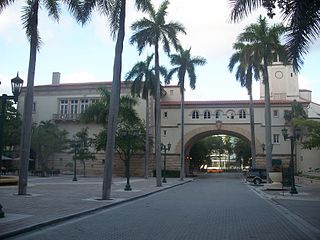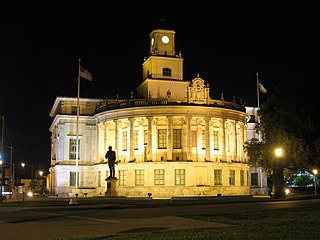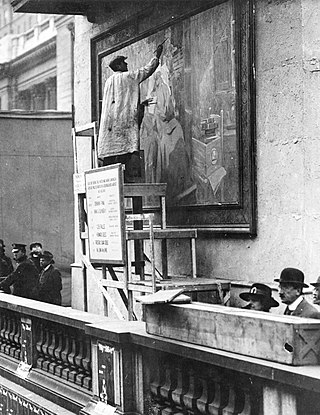
Coral Gables is a city in Miami-Dade County, Florida, United States. The city is part of the Miami metropolitan area of South Florida and is located 7 miles (11 km) southwest of Downtown Miami. As of the 2020 U.S. census, it had a population of 49,248.

Coconut Grove, also known colloquially as The Grove, is an affluent and the oldest continuously inhabited neighborhood of Miami in Miami-Dade County, Florida. The neighborhood is roughly bounded by North Prospect Drive to the south, LeJeune Road to the west, South Dixie Highway and Rickenbacker Causeway to the north, and Biscayne Bay to the east. It is south of the neighborhoods of Brickell and The Roads and east of Coral Gables. The neighborhood's name has been sometimes spelled "Cocoanut Grove" but the definitive spelling "Coconut Grove" was established when the city was incorporated in 1919.

Fairchild Tropical Botanic Garden is an 83-acre (34 ha) botanic garden with extensive collections of rare tropical plants including palms, cycads, flowering trees, and vines. It is located in the city of Coral Gables, Miami-Dade County, just south of Miami, surrounded at the north and west by Matheson Hammock Park.

Venetian Pool is a historic U.S. public swimming pool located in Coral Gables, Florida. Completed in 1924, it was designed by Phineas Paist with Denman Fink.

George Edgar Merrick was a real estate developer who is best known as the planner and builder of the city of Coral Gables, Florida in the 1920s, one of the first major planned communities in the United States.

Edison Courts is a Miami-Dade 345-unit public housing apartment complex just west of the Little Haiti neighborhood of Miami, Florida. Edison Courts is bounded to the south by North 62nd Street/Martin Luther King, Jr. Boulevard, by North 67th Street to the north, by West Second Avenue to the east, and by West Fourth Avenue to the west.

The Douglas Entrance is a historic site in Coral Gables, Florida. It is located at the junction of Douglas Road and Tamiami Trail. The architect was Phineas Paist and it was completed in 1924. On September 22, 1972, it is listed on the U.S. National Register of Historic Places.

Miracle Mile is a 0.503-mile-long (0.810 km) section of Coral Way between LeJeune Road and Douglas Road in Coral Gables, Florida. It is the main east-west road through the city's downtown central business district, consisting of many shops, financial institutions, restaurants and arts institution. The LeJeune Road end of Miracle Mile is anchored by the Coral Gables City Hall.

Coral Gables Preparatory Academy, formerly Coral Gables Elementary School, is a public K-8 school in Coral Gables, Florida. A part of the Miami-Dade County Public Schools, it has its elementary school classes in the Lower Academy, in the former Coral Gables Elementary building, while the middle school classes are in the Upper Academy at the Merrick Educational Center. The school was given its current name in 2010.

The Coral Gables City Hall is a historic site in Coral Gables, Florida. It is located at 405 Biltmore Way. On July 24, 1974, it was added to the U.S. National Register of Historic Places.

The Plymouth Congregational Church is a historic church located at 3429 Devon Road corner of Main Highway in the Coconut Grove in Miami, Florida.

August Geiger was one of the most prominent American architects in South Florida from 1905 to the late 1940s. He experimented in Mission, Neo-Renaissance and Art Deco architecture, but is most noted for his works in the Mediterranean Revival style. A number of his works are listed on the U.S. National Register of Historic Places.
R.E. Chisholm Architects, Inc. is a full-service architectural, interior design and urban design firm located in Miami, Florida. It was founded in 1982 by Robert E. Chisholm, FAIA. The firm was known as CSR Architects from 1983 through 1989. In 1989, the firm was incorporated and grew to its current status. Robert E. Chisholm originally adopted the firm philosophy of maintaining a variety of project types and experience which would develop the thinking and attitude of the firm in a consistent direction of architects in responsible leadership of each project. Chisholm Architects has designed numerous projects which include offices, restaurants, theaters, schools, university facilities, medical centers, commercial & retail sites, institutional & cultural centers, single and multi-unit residences, rapid transit stations, and aviation facilities. In 1996 Robert E. Chisholm was named Fellow of the American Institute of Architects, the highest honor attainable in this 150-year-old organization and in 2007, Mr. Chisholm was awarded the State of Florida AIA Silver Medal for Architecture.

The David W. Dyer Federal Building and U.S. Courthouse, formerly known simply as the U.S. Post Office and Courthouse, is an historic United States Post Office and federal courthouse of the United States District Court for the Southern District of Florida located at 300 Northeast 1st Avenue in Miami, Florida. Built in 1931 of limestone, it is the largest such structure in South Florida.

Phineas P. Paist was an American architect who was the supervising architect for the Coral Gables Corporation.

Miami-Dade County is a county located in the southeastern part of the U.S. state of Florida. The county had a population of 2,701,767 as of the 2020 census, making it the most populous county in Florida and the seventh-most populous county in the United States. It is Florida's third largest county in terms of land area with 1,946 square miles (5,040 km2). The county seat is Miami, the core of the nation's ninth-largest and world's 65th-largest metropolitan area with a 2020 population of 6.138 million people, exceeding the population of 31 of the nation's 50 states as of 2022.

The architectural firm of Kiehnel and Elliot was established in Pittsburgh, Pennsylvania, in 1906. The firm did substantial work in Florida, and moved to Miami in 1922. From 1926, it was known as Kiehnel, Elliot and Chalfant.

Matheson Hammock Park is a 630 acres (2.5 km2) urban park in metropolitan Miami at 9610 Old Cutler Road, just south of Coral Gables, Florida. The park surrounds the north and western ends of Fairchild Tropical Botanic Garden.

Denman Fink (1880–1956) was an American artist and magazine illustrator.






















